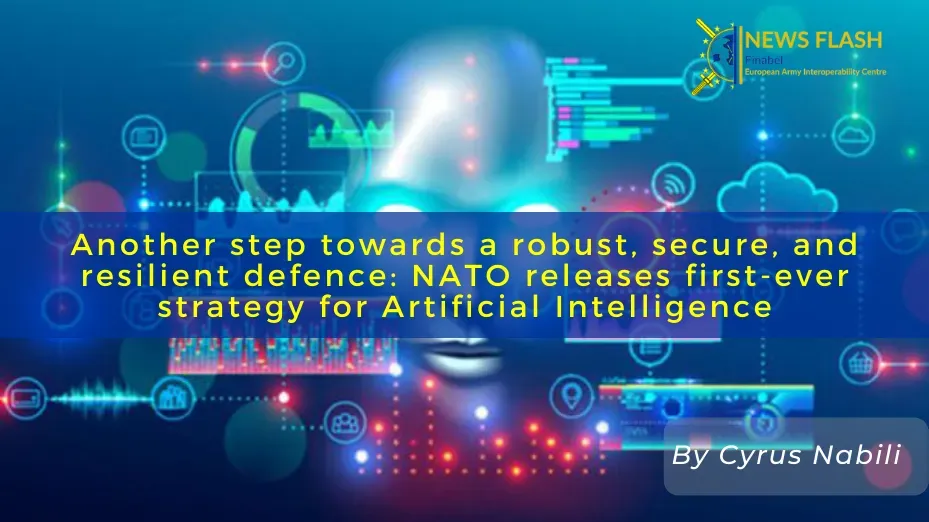In recent years, the NATO AI strategy has emerged as a crucial roadmap for enhancing the alliance’s capabilities in artificial intelligence, particularly against the backdrop of escalating global tensions. As NATO member nations gather to refine their defense technology, the urgency to integrate AI into military operations has never been more pronounced. Europe faces a daunting challenge in the AI competition with powerhouses like the United States and China, whose advancements pose a direct threat to European security. With significant UK AI investment propelling its initiatives, NATO aims to establish a robust framework that leverages cutting-edge technologies for tactical superiority. The collective goal is to ensure that Europe does not fall behind in the evolving artificial intelligence landscape that will undoubtedly shape future warfare.
The strategic incorporation of intelligent technologies within NATO’s framework signifies its commitment to adapting to the rapidly changing military landscape. By emphasizing the critical role of AI in defense innovation, NATO is not only addressing the pressing concerns of European nations about emerging threats, particularly from China, but also striving to maintain competitive parity in global military arenas. This entails a comprehensive examination of previous conflicts and the lessons learned, alongside a significant push towards enhancing collaborative efforts among member states. As nations invest in modernizing their military capabilities, the integration of AI represents a vital component of national security strategies aimed at ensuring effective deterrence against adversaries. Ultimately, the evolution of NATO’s defense paradigm is focused on fostering resilience and adaptability in the face of technological progress.
The Necessity for NATO’s AI Strategy
In response to the evolving landscape of warfare, NATO has recognized the urgent need for an effective artificial intelligence (AI) strategy. As conflicts increasingly rely on advanced technologies, the integration of AI within NATO operations is not just a strategic option but a necessity. Experts assert that the next major conflict will demand innovations that extend far beyond the capabilities of current drone technologies. This urgency was a central theme during the recent NATO summit in The Hague, where discussions underscored the importance of adopting cutting-edge AI solutions to stay competitive against adversaries such as Russia and China.
The implementation of a robust AI strategy is intertwined with NATO’s ability to enhance collective defense mechanisms. While the United States has made significant strides in AI research, European nations must navigate internal divisions regarding AI regulations and safety practices. The disparity in AI capabilities can potentially weaken NATO’s overall effectiveness, particularly when facing threats from state actors who are rapidly advancing their own AI technologies. Therefore, establishing a cohesive AI strategy is critical for NATO to remain at the forefront of defense technology and deter potential aggressors.
Europe’s AI Competition in Defense
In the face of heightened competition in the AI sector, European nations are under pressure to strengthen their defense technologies to keep pace with the United States and China. Both countries currently dominate the AI landscape, possessing advanced computing capabilities and extensive research funding that outstrip European investments. The UK, however, stands out as a significant player, having pledged a substantial increase in AI investments coupled with partnerships with leading American tech firms. The latest defense strategy highlights the UK’s commitment to embedding AI into its NATO-first security agenda, aimed at enhancing operational effectiveness across the alliance.
As Europe navigates the complexities of AI competition, it is imperative to recognize the lessons learned from the ongoing conflict in Ukraine. Nations like Germany and France are revitalizing their defense sectors by incorporating advanced AI technologies for automated surveillance and data processing. However, the collective effort still lacks cohesion, reflected in a reliance on U.S. technology providers like Palantir for system integration. These developments illustrate the need for Europe to foster its own AI capabilities to achieve independence in defense technology, enabling it to respond more adeptly to potential threats.
The Implications of China’s AI Threat
China’s advancements in artificial intelligence represent a significant challenge to NATO’s defense posture. As the country arises as a formidable AI superpower, its military applications of AI technology are becoming increasingly sophisticated, prompting concerns among NATO allies. The perception that the United States may prioritize its focus on China could inadvertently leave Europe vulnerable to Russian threats, especially if European countries do not enhance their own AI capabilities. This geopolitical landscape necessitates a reevaluation of alliances and a unified response to counterbalance China’s growing influence in AI and military applications.
NATO must address the dual-faceted threat presented by China, not only in terms of military prowess but also in the technological advancements that accompany it. A robust response requires not just military enhancements but also strategic collaborations, investments in AI research, and the establishment of regulations to govern AI technologies within Europe. The understanding that AI will shape future conflicts underscores the importance of cooperation among NATO nations to develop a unified front that leverages innovation while deterring adversarial strategies effectively.
UK’s Leadership in AI Investment
As military tensions ramp up, the United Kingdom has emerged as a leader in artificial intelligence investment within NATO. Ranking third globally in government expenditure on AI research, the UK is setting a precedent for its partners in establishing robust defense mechanisms based on AI technology. This proactive approach signifies a commitment to enhancing national security while aligning with NATO’s collective defense goals. Such initiatives not only bolster operational effectiveness but also foster strategic partnerships that are critical in a landscape where competing with China in AI is essential.
The UK’s recent defense strategy underlines the integration of AI into its military programs, a vital aspect of its long-term commitment to NATO. This aligns with global trends where countries recognize AI as pivotal in future warfare. The engagement with various tech firms, both domestically and in the US, showcases the UK’s determination to bridge the technology gap and ensure that its armed forces remain competitive. By championing AI investment, the UK plays a crucial role in reshaping NATO’s defense technology landscape, paving the way for more adaptive and smarter military capabilities.
The Role of Data in Military AI Development
Data is at the heart of any successful artificial intelligence strategy, particularly in military applications. For NATO, the effective use of data analytics can transform its operational capabilities, enabling smarter decision-making in the face of conflict. However, European nations face significant challenges in securing access to substantial data sets necessary for training AI systems. The disparity in data resources compared to the US and China underscores the need for Europe to cultivate an environment that not only prioritizes data collection but also emphasizes cooperation among member states to share intelligence.
The integration of advanced data collection techniques into NATO operations is essential for harnessing the full potential of AI technologies. As European firms innovate in the landscape of surveillance and reconnaissance, NATO must champion initiatives that prioritize access to real-time data analytics and software capabilities. This approach can enable more coherent and effective responses to threats, whether they arise from cyber warfare or traditional military engagements. A comprehensive data strategy will be instrumental in ensuring that NATO remains resilient and adaptive in the evolving technological battlefront.
AI’s Impact on Future Warfare
The intersection of artificial intelligence and military strategy is reshaping the concept of warfare as NATO prepares for future conflicts. AI technologies promise to enhance operational efficiency, increase precision in military operations, and reduce human error. As warfare becomes more technologically driven, NATO must evolve its tactics and strategies to incorporate these advancements effectively. The forecasts suggest that future engagements will rely less on conventional forces and more on intelligent systems designed to operate autonomously in complex environments.
Furthermore, the integration of AI into military frameworks poses ethical and regulatory challenges that NATO must navigate. While the strategic advantages are apparent, the potential for misuse or unintended consequences necessitates a robust regulatory framework governing AI deployment in military operations. As NATO grapples with these complexities, collaboration among allies to establish common ethical guidelines will be vital in ensuring responsible AI usage. The implications of AI technologies on warfare extend beyond operational capacity; they redefine the principles of engagement and necessitate a reassessment of international norms regarding conflict.
Strategic Partnerships in AI Innovation
For NATO to remain competitive in the realm of artificial intelligence, cultivating strategic partnerships within the technology sector is essential. Collaborations with leading tech firms, particularly those in the US and Europe, can accelerate military innovations and provide NATO members access to the latest advancements in AI. These partnerships can enhance the alliance’s capacity to implement advanced technologies in defense systems, thereby maintaining a strategic edge against adversaries.
However, fostering such partnerships requires navigating complex geopolitical landscapes and ensuring that technology transfers do not compromise national security. As European nations seek to enhance their defense capabilities through collaboration, establishing clear frameworks for cooperation becomes imperative. By tapping into the expertise of AI innovators, NATO can bolster its technological foundations while fostering an ecosystem conducive to rapid advancements in military applications. This connection between defense and technology will be critical in addressing the dynamic challenges posed by global powers.
Challenges in AI Regulation within NATO
While the adoption of artificial intelligence offers numerous advantages to NATO’s defense operations, the inconsistencies in regulatory frameworks pose significant challenges. Member states have differing approaches to AI development, particularly concerning safety measures and ethical considerations. These disparities can lead to friction within the alliance as countries strive for a cohesive AI strategy that aligns with national interests while upholding the principles of collective defense.
A harmonized regulatory framework is necessary to mitigate risks associated with AI deployment in military applications. Without a unified approach, NATO risks compromising operational integrity and facing reputational challenges in the international arena. Streamlining regulations that govern AI technologies across member states will not only enhance cooperation but also signal a commitment to responsible innovation within the alliance. It is essential for NATO to convene discussions focused on establishing common ground for AI policies, ensuring that all allies can proceed confidently in leveraging AI technologies.
Conclusion: The Future of NATO and AI
As NATO evolves to meet the challenges of modern warfare, its focus on artificial intelligence will be a defining feature of its future strategy. The integration of AI into defense operations is paramount to maintaining technological superiority over adversaries. With ongoing developments in AI competition, particularly concerning the US and China, NATO must forge a path that prioritizes innovation while ensuring the security of its member states.
The successful adaptation to AI technologies will require a commitment from all NATO allies to collaborate on research, share data, and establish common regulatory standards. Moving forward, the alliance must embrace a comprehensive approach to AI that encompasses not just technological advancements but also ethical considerations. In doing so, NATO can reinforce its position as a leading defense alliance, equipped to navigate the complexities of future conflicts and emerge resilient in the age of artificial intelligence.
Frequently Asked Questions
What is NATO’s AI strategy and why is it important for European security?
NATO’s AI strategy focuses on integrating artificial intelligence into its operations to enhance military effectiveness and address security threats in a rapidly evolving technological landscape. This strategy is crucial for European security as it aims to bolster defense against challenges posed by adversaries like Russia and to compete effectively against AI advancements from nations like China.
How is artificial intelligence being utilized in NATO defense technology?
Artificial intelligence is being utilized in NATO defense technology through heightened data collection and processing systems, automated surveillance, and advanced combat systems. The recent agreement with Palantir highlights NATO’s commitment to incorporating AI into military operations, enabling better decision-making and operational efficiency.
What actions has NATO taken to accelerate the adoption of artificial intelligence?
NATO has committed to expediting the implementation of artificial intelligence by signing partnerships with technology firms, increasing investment in AI research, and urging member nations to enhance their intelligence capabilities. Recent discussions and decisions at NATO summits emphasize the urgent need for AI integration in response to new military challenges.
How does the UK contribute to NATO’s AI strategy amid the Europe AI competition?
The UK plays a significant role in NATO’s AI strategy by being the third largest global investor in AI research and establishing strategic partnerships with U.S. technology companies. Its recent defense strategy underscores the importance of integrating AI into its national security framework, positioning the UK as a leader within NATO amidst growing competition in artificial intelligence.
What challenges does Europe face in competing with the AI capabilities of China?
Europe faces several challenges in competing with China’s AI capabilities, including a lack of robust domestic AI development and limited technological partnerships compared to China. There are also divisions within NATO regarding AI regulation and safety, which can impede a cohesive and effective response to threats in the AI-dominated future battlefield.
What lessons has NATO learned from conflicts in Ukraine regarding artificial intelligence?
NATO has learned that the integration of artificial intelligence can significantly enhance military effectiveness, as demonstrated by the utilization of sophisticated data systems and automated technologies in Ukraine. These lessons stress the need for rapid adaptation and technological advancement to deter adversaries effectively.
How does NATO plan to counter the perceived AI threat from China?
NATO plans to counter the AI threat from China by accelerating the adoption of advanced technologies, enhancing defense collaborations among member states, and prioritizing investment in research and development of cutting-edge AI systems. This includes focusing on intelligence sharing and the development of advanced cyber capabilities essential for national security.
What impact could AI have on future NATO military operations?
The integration of AI into NATO military operations could lead to greater efficiency, improved decision-making processes, and enhanced strategic capabilities. It is expected that AI will transform operational tactics in warfare, necessitating continuous innovation and adaptation to remain competitive against adversary capabilities.
| Key Points | Details | Implications |
|---|---|---|
| NATO Acceleration of AI | NATO allies agreed to adopt AI in operations to keep pace with future warfare needs. | Europe fears being outpaced by the US and China in military AI capabilities. |
| Concerns about US Focus | The US is prioritizing threats from China, potentially neglecting European needs against Russia. | European nations may lack support and technology from the US to develop their AI strategies. |
| UK’s Role in AI | The UK pledges to integrate AI into its national defense strategy and ranks third in government AI investment. | This commitment positions the UK as a key player in NATO’s AI strategy, influencing other members. |
| Challenges for Europe | European firms are developing AI technology but are still behind the US and China in cutting-edge capabilities. | Limited access to advanced AI hinder’s Europe’s effectiveness in military applications. |
| Russia’s Position | Russia uses cyberattacks and drones but is not a leader in AI development. | Potential collaboration with China could enhance Russia’s technological capabilities. |
Summary
The NATO AI strategy emphasizes the alliance’s commitment to enhancing its military capabilities through the integration of artificial intelligence. As European countries express concerns about being overshadowed by the capabilities of the US and China in this critical domain, a significant focus is placed on developing advanced technologies that can ensure a competitive edge on future battlefields. With increased urgency, NATO aims to foster collaboration and innovation in AI, crucial for maintaining its strategic advantages.



